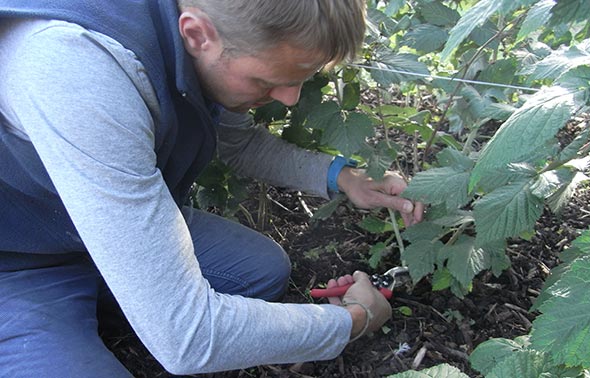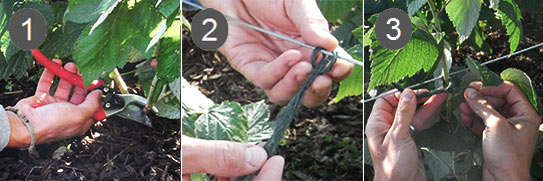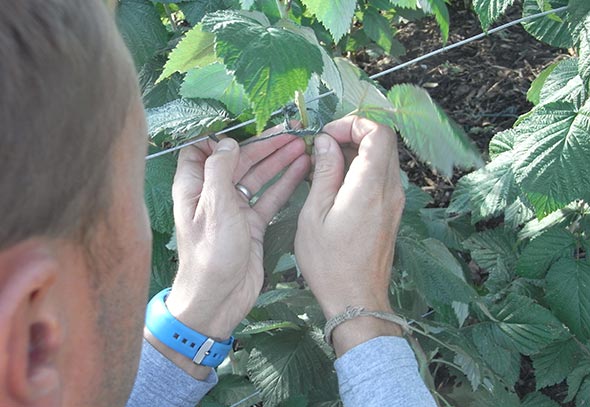Glen Ample is a well known spine free variety of self fertile raspberry that produces exceptional yields (up to 1Kg per foot of cane) of firm fruit that have an excellent flavour. I have a small row of them planted in a sunny, south facing spot in my garden. The fruits are a mid-summer fruiting ‘Floricane’ variety which means it produces fruit on second year wood. Glen Ample starts to crop in early July, the biggest crops are at the end of July and it tails off somewhere around mid-August. Our bees certainly like them and the RHS actually recommend them as an excellent nectar source so I can see why.

Glen Ample are a variety that is protected by the ‘Plant Variety Rights’ which basically means it is illegal to propagate them without first obtaining a license. Glen Ample are raised at the Scottish Crop Research Institute and come from a number of crosses that include ‘Meeker’ and ‘Glen Prose’.
I love raspberries, they are really easy to grow on reasonably rich, free draining soil and are far better ripe and freshly picked than the ‘supermarket varieties’ that don’t have the flavour. They do need some rainfall to grow into reasonable sized fruits so if we have a dry summer, I will water them from our rain water store.
So how do you prune Glen Ample Raspberries? Well, perhaps I should say ‘how do you prune Floricane varieties?’ or even ‘how do you prune summer-fruiting varieties?’ because they all follow the same method.
There are two groups of raspberry you will come across. Summer-fruiting (like Glen Ample) and Autumn-fruiting. Summer-fruiting varieties grow on second year wood, so what grew last year will have fruit on it this year. This means we need to cut back the canes in September.
How to Prune Summer Fruiting Raspberries – Step by Step

Summer-fruiting varieties do need some sort of permanent support, I use a 5ft post at the end of each row and have run 3 galvanised wires between them. Canes can be tied onto the wires with soft gardening twine.
1
Remove all previous year’s growth (brown woody stems that had fruit on them this year). Prune this growth down to the ground. Next, reduce new growth to 4-6 good canes to each plant. If you leave growth unchecked, you can end up with a dozen or so canes per plant which cannot support good size fruit on all canes. Pruning means the plant’s resources are concentrated and you will get the best sized fruit.
2
Cut some 8″ long pieces of string or twine. Make a loop around the galvanised wire to attach it. Repeat this on all 3 wires as you go up and for all canes as you work along the row.
3
Tie in ‘this year’s growth’ – (the fresh, pale green stems) to your support framework. These will be next year’s fruiting stems. Stems can be tied vertically to the lower support but bent horizontally and tied to the upper wires.
That is all there is to it! It takes me a couple of hours to complete 24 plants but I think it’s a rewarding job.

Incidentally, if you have autumn-fruiting varieties, these fruit between August and November and the fruits grow on this year’s growth. This means we can cut back all growth in February, allowing fresh growth the following year with fruits appearing in the autumn. They don’t need much support, perhaps a little to stop them touching the ground as the fruits start to weigh them down.

HI Tim, I got glen ample canes last year, cut them down short after planting as per their instructions but they didnt grow much, say only about 10 inch, but then they fruited.
Im a little confused now what to do, as they have fruited do I cut them back?, this will then leave no other growth as they put on no new growth last year just these 10inch shoots that fruited
thanks for any help you can give
John
Hi John,
This sounds normal. The fruit will have appeared on the ‘old wood’ canes and some of this you will have cut back so you wouldn’t get much fruit in the first year. The new growth will be ‘green wood’ canes and is normally quite vigorous.
In the autumn, after fruiting, you need to cut all of the ‘old wood’ down to the ground, leaving the ‘green wood’ (i.e that years’ growth) ready for next years’ fruit. Tie these in to wires so they don’t get damaged by wind over the winter. Next summer it will be these that have turned woody and will bare your fruit.
If the growth is only 10 inches, I would wait to see if they get going in the spring and put on some new, larger ‘green wood’ canes for next year. If they don’t grow much I would look at the soil for answers. They aren’t too fussy. Mine grow well with a mulch of manure and have had some chicken manure pellets over the first couple of years mixed in with the surrounding soil.
I hope this makes sense. Let me know if you need me to explain further.
Hi, I bought 5 new canes last year and put them in at the beginning of November. Only two of them grew. Can I propagate a couple more from those plants? If so, how and when should I do it?
Thanks.
When they get going, they will put fairly shallow roots out either side of the row. You will usually get shoots popping up in pathways. Let these grow and then in the winter, prune it to a stick (about 2/3 off), dig it out and detatch the root from the main plant, leaving the other roots intact.
Thanks for your help in pruning Glen Ample…its my first year! When you say to tie them in vertically to the top two wires do you mean to bend over the canes and tie them in? if you do then I don’t think I have left enough room between each plant! How far apart should they be when you plant them?
Thanks.
Yes, if they have grown well, they may be taller than your wires. If they are a little longer (say 1ft) and won’t be damaged by winter winds then I keep them vertical. If they are really long, lay them horizontal along the top wire with a gentle curve so as not to cause too much strain on the stem. They may overlap one-another in places, it can’t be helped and doesn’t hurt. You’ll get fruit on these stems next year 🙂
I planted mine about 18″ apart.
Thanks very much for your help!